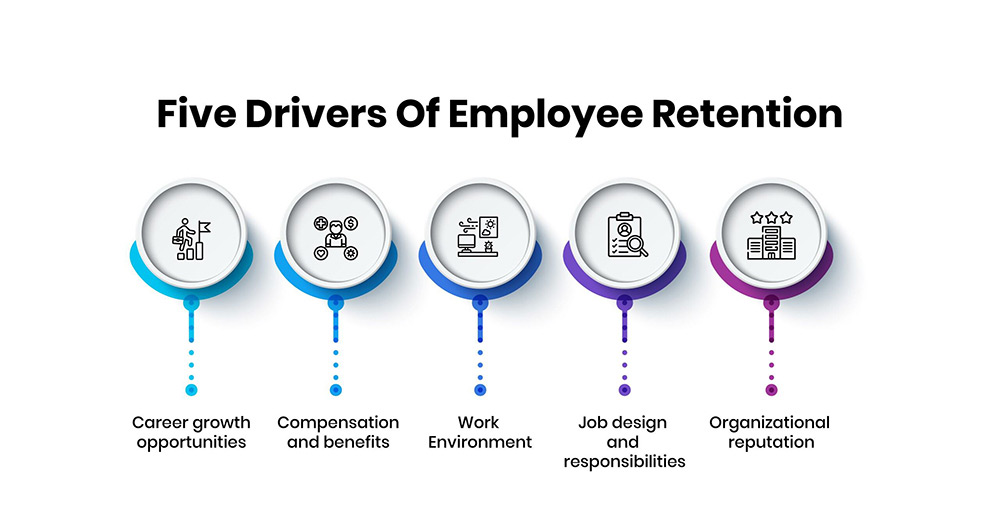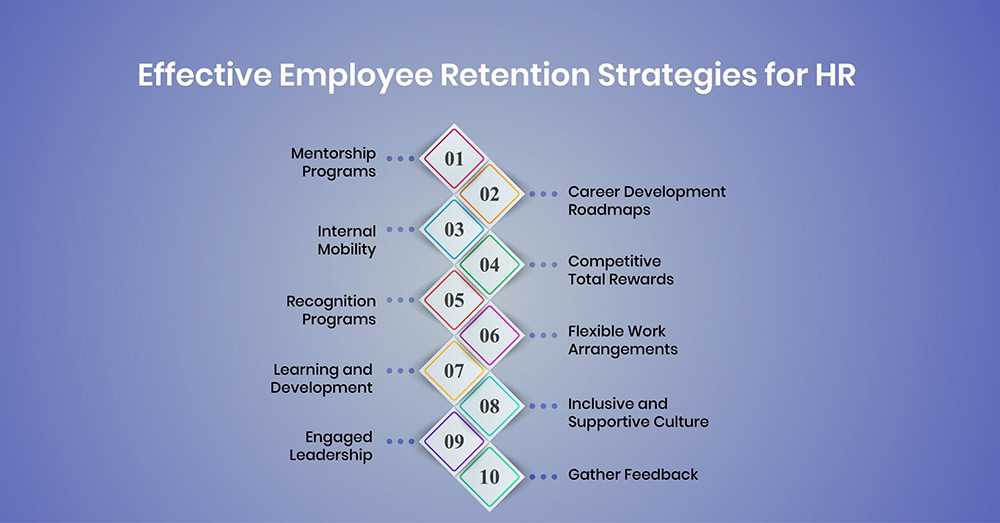Why Employee Retention Matters: Key Drivers and Effective Strategies
September 13, 2024

Employee retention has become one of the top priorities for HR professionals and business leaders alike. In today’s competitive labor market, organizations are struggling to find and retain talent. Implementing effective employee retention strategies can help you attract and retain the best people.
This article will explore why employee retention matters, key drivers, and discuss proven strategies HR teams can utilize to build an engaged workforce. Let’s get started.
Why Does Employee Retention Matter?
There are several compelling reasons why employee retention should be a top priority for any organization:
-
Cost savings
Replacing an employee is an expensive process. It is much more cost-effective for organizations to focus on retaining existing talent rather than continuously recruiting and onboarding new hires.
-
Knowledge retention
When an organization loses an employee, it also loses invaluable industry and organization-specific insights that can negatively impact decisions and performance.
-
Productivity
New hires take time to get up to speed and become truly productive in their roles. Organizations with more stable workforces and lower turnover suffer fewer interruptions and delays as employees are not constantly needing to ramp up. This allows the workforce to be more productive overall.
-
Competitive advantage
Providing opportunities for talent development and growth is an effective retention strategy as it helps attract and retain talent. This can give organizations a competitive advantage by building a more competent workforce. Strong retention also demonstrates an organization's commitment to its people, helping it attract new talent and gain an edge over competitors in tight hiring markets.
-
Customer satisfaction
Consistency in staffing leads to better customer relationships and enhances their overall experience. Customers appreciate interacting with familiar faces and building long-term connections. High turnover disrupts this continuity, requiring customers to repeatedly form new relationships with different staff members. Stable workforces retain knowledge of customer needs and provide a more seamless customer experience.
What Drives Employee Retention?
There are five main drivers that influence an employee's decision to stay with an organization:

-
Career growth opportunities
Employees want room for growth and development. This is a major reason cited for leaving by employees in exit interviews. When organizations provide opportunities for employees to learn new skills and take on more responsibilities through training programs, mentoring initiatives, and internal mobility options, it satisfies their need for progress in their careers.
Employees are more likely to remain with companies that invest in helping them reach their full potential through professional growth. A lack of career advancement paths demotivates high performers and makes them seek opportunities elsewhere. Organizations must establish clear career trajectories for all roles to retain top talent.
-
Compensation and benefits
Pay is a crucial retention factor. Employees want to feel fairly rewarded for their work through competitive salaries. When pay is not considered equitable compared to the labor market or contribution level, employees start searching for organizations willing to compensate them better.
Beyond pay, total rewards like medical insurance, paid time off, bonuses, retirement funds etc. are also important. Organizations that want engaged workforces need to regularly review their compensation strategies and ensure a strong benefits package. Compensation alone may not motivate, but inadequate pay can swiftly lead to high turnover.
-
Work environment
The conditions where work gets done have a considerable influence on whether employees stay. A positive, supportive culture with an emphasis on work-life balance, flexible arrangements, collaboration and respect between team members and managers fosters employee well-being and loyalty.
Cultural elements such as trust, collaboration, and mutual respect create a positive and enjoyable workplace environment. By contrast, unfavorable conditions like constant overtime, micromanagement styles, and workplace politics quickly burn out even committed employees. Turnover is high in organizations that do not prioritize creating healthy, productive work environments.
-
Job design and responsibilities
When jobs are merely transactional without any mental challenge or purpose, employees get disengaged and bored. But when roles are designed to harness individuals' strengths through engaging in meaningful responsibilities, it produces motivation and satisfaction.
Organizations serious about retaining top talent ensure jobs are well-structured to keep occupants learning, improve their skills, and make an impact through their work. Otherwise, underutilized skills and lack of engagement prompts even satisfied employees to explore new opportunities elsewhere.
-
Organizational reputation
Employees derive pride from associating with esteemed employers. Organizations known for their excellence in products/services, innovation, leadership or social missions find it easier to attract and retain employees. By contrast, lackluster performance or negative perceptions about an employer's direction make it a struggle to hire and keep talent. Even if all other retention factors are addressed, a company with a questionable public image will constantly struggle with retention.
Organizations must strategically address these to create an environment where people want to build long careers.
10 Effective Employee Retention Strategies for HR
Here are 10 evidence-based employee retention strategies that HR teams can implement:

-
Mentorship Programs
Formal mentorship connects new and junior employees to senior leaders and subject matter experts. This helps them gain skills, advice, and sponsorship, and integrate more fully into the organization sooner. Research shows mentorship reduces intentions to quit.
-
Career Development Roadmaps
Everyone wants to feel like they’re growing in their career. Provide clear paths to progress through roles, skills gain, projects, and promotions with individualized development roadmaps. This fosters engagement and higher retention.
-
Internal Mobility
Challenging internal moves and secondments give employees new experiences while remaining with the company. Highlight these mobility opportunities to tap existing talent for openings whenever possible vs. external hires.
-
Competitive Total Rewards
Pay, healthcare benefits, paid time off, flexibility, bonuses - holistically benchmark your total rewards package and ensure it's competitive. Financial security and perks make employees less price-sensitive about external job moves.
-
Recognition Programs
Simple, frequent, authentic recognition for achievements builds employee pride, engagement and loyalty. Research public and private wins, utilize peer-to-peer recognition tools and strengthen your overall recognition culture.
-
Flexible Work Arrangements
Make flexibility a standard rather than an exception to accommodate varying employee needs. Options like remote work, flex time, comp time, and leave allow people to maintain career-life integration.
-
Learning and Development
Enable continual skill-building through classroom, online and on-the-job training methods, subsidized education, certifications, and growth initiatives. Nurture a culture where learning is valued in the long run.
-
Inclusive and Supportive Culture
Diversity, equity and inclusion practices, as well as flexible work policies, help all employees bring their whole selves to work. Such environments attract and retain marginalized talent.
-
Engaged Leadership
Ensure managers are equipped to effectively lead, develop teams and champion work-life balance. Accountability for retention metrics and mentoring/coaching fosters strong employee-manager bonds critical to staying put.
-
Gather Feedback
Conduct stay and exit interviews to gauge engagement levels and address any issues to improve retention proactively. Gathering unvarnished feedback lets you enhance your employee value proposition continuously.
Conclusion
To effectively retain top employees, organizations should implement strategies that promote fair compensation, opportunities for growth, work-life balance, recognition for contributions, and an inclusive company culture where all feel valued. Regular communication, feedback and training can boost engagement. Retaining key staff saves costs and preserves institutional knowledge, helping the organization perform better and sustain growth.


